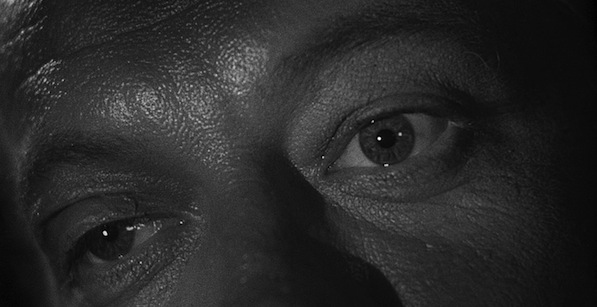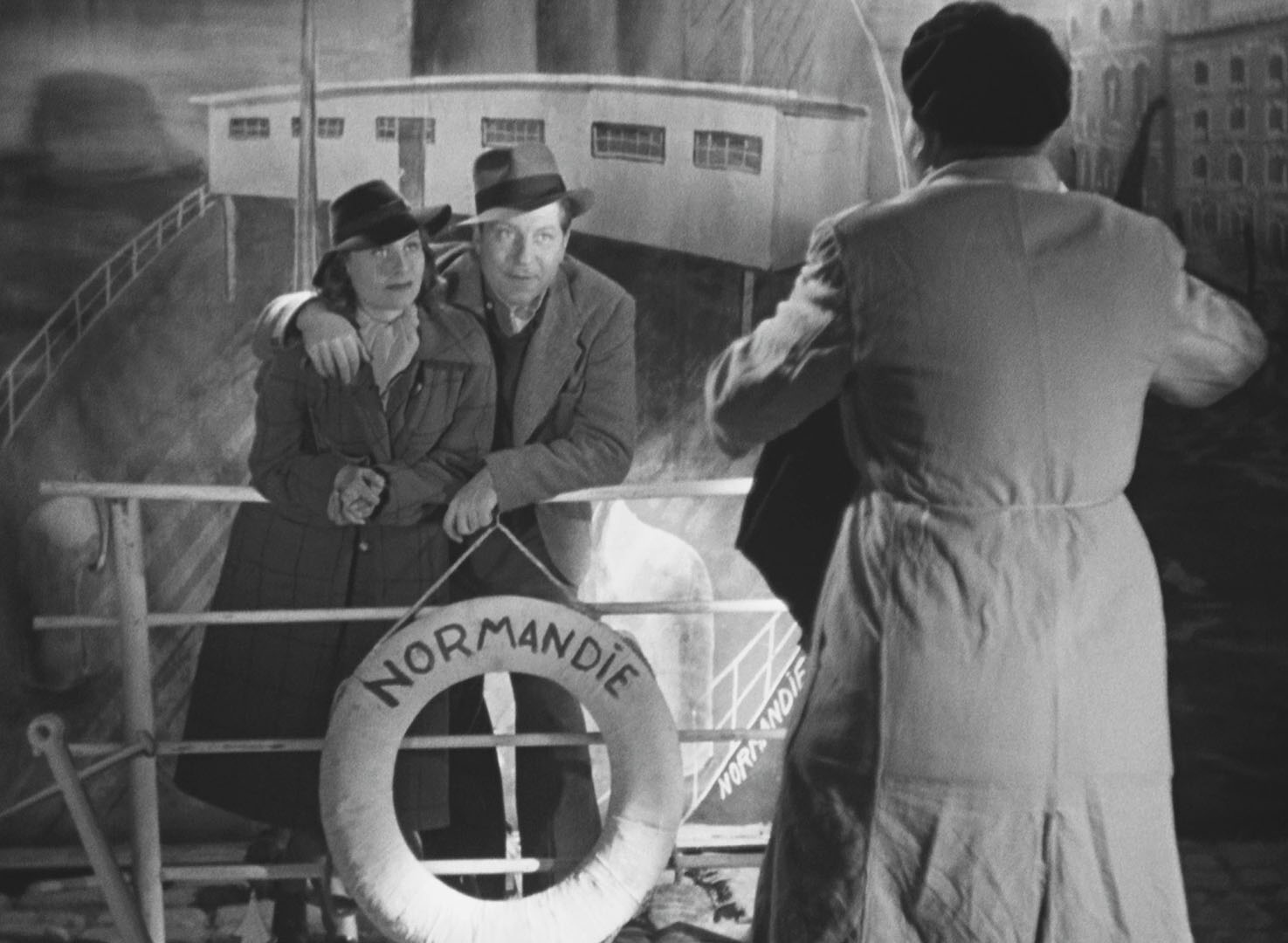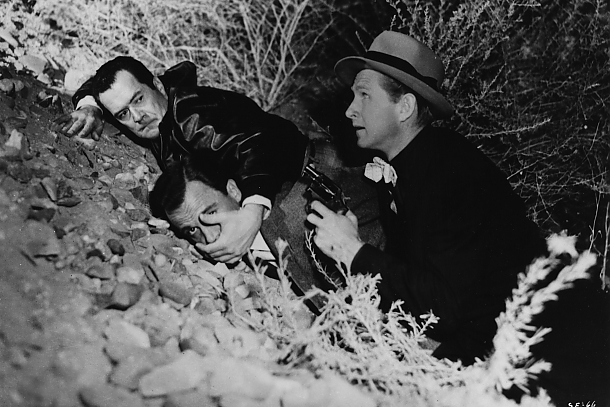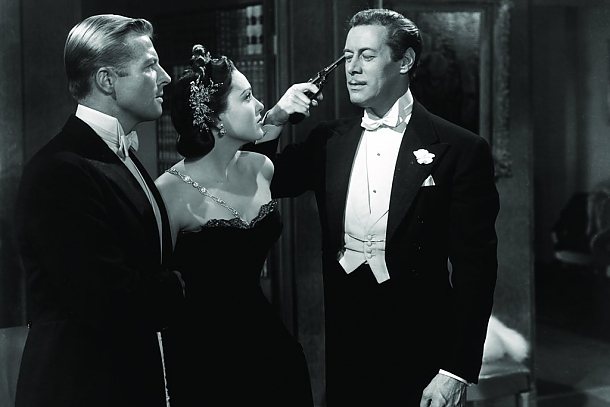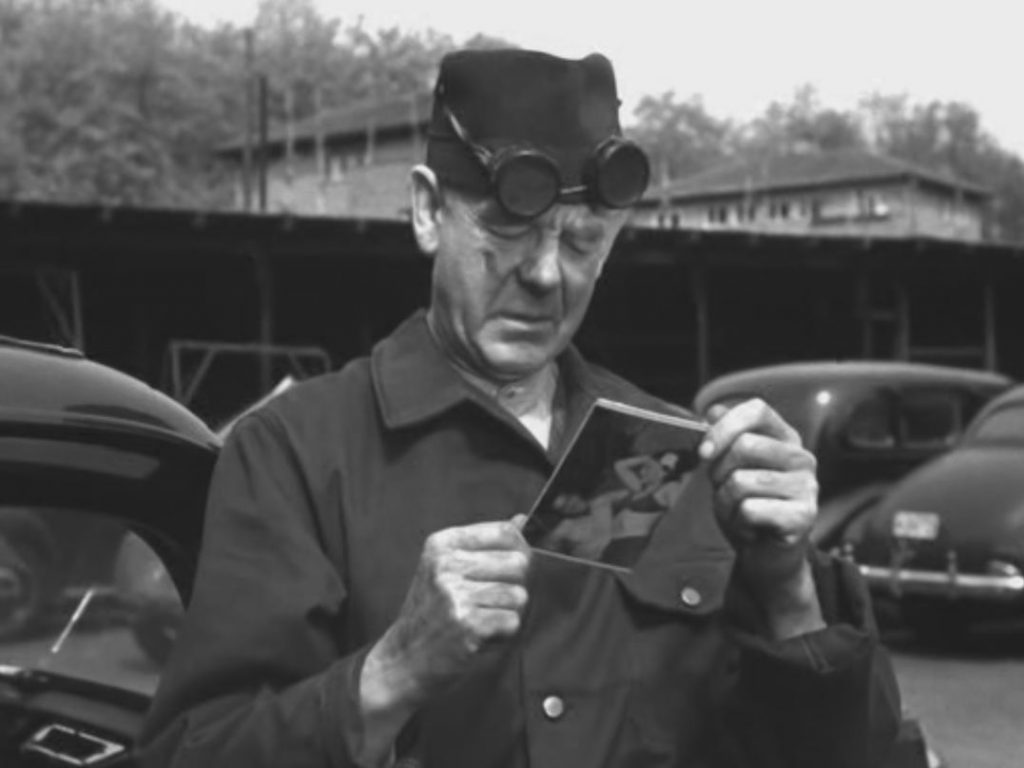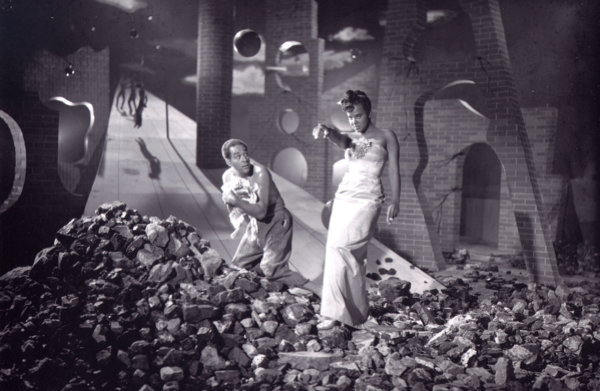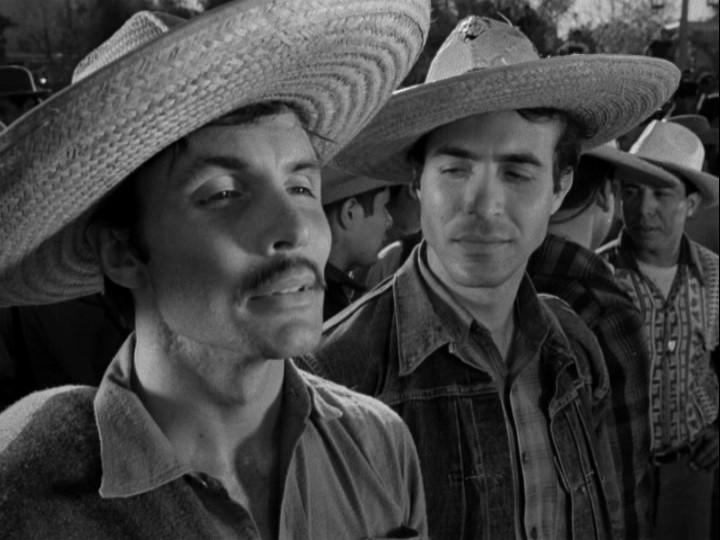It’s no mere accident of history that noir has become the English-speaking film world’s foremost loan word—with apologies to auteur and the apocryphal mit out sound. It’s well known that the term film noir was first applied to Hollywood film adaptations of hard-boiled crime novels (The Maltese Falcon, Double Indemnity, Murder, My Sweet, etc.) after the fact, by French critics who were finally catching up with American films that hadn’t been exported to continental Europe during World War II. But these films, and their many lower-budgeted brethren that were labeled “red meat” films or simply “thrillers” by Hollywood press of their day, had not been created in a vacuum. They’d been made by men profoundly influenced by European films: the shadows-and-smoke Expressionism of Weimar Germany, the noose-tightening suspense of Alfred Hitchcock’s British masterpieces, and the fatalistic Poetic Realism of 1930s French directors like Marcel Carné and Jean Renoir. Jean-Pierre Chartier’s 1946 article which discusses the social-problem picture The Lost Weekend along with the aforementioned three crime films is in fact titled “Les Americains aussi font des films ‘noirs,’” or “Americans also Make Noir Films,” and compares them to “a French school of film noir” already established and including Carné’s Port of Shadows and Hôtel du Nord.
This is the way it has ever been, since the days when it was first realized how much cheaper it is to ship a 35mm reel overseas than to send a theater troupe. For all the emphasis on “national cinema” over the years, motion picture history has few instances of true geographical isolation for any significant period of time. There has always been a demand for the world’s most remarkable movies in any country with movie specialists and filmmakers among its number, even if that demand is constrained, by protectionist or parochial forces, to be shared by only a limited few and not the masses. So The Cabinet of Dr. Caligari, The 39 Steps and Pépé le Moko were seen almost everywhere in their day, planting seeds of inspiration for many future filmmakers who sought them out. So, eventually, was Double Indemnity.
If by the late 1940s film noir had spread like transmittable bacteria across borders and oceans to receptive hosts on every continent, it was certainly helped along by international events. Sheri Chinen Biesen, in her book Blackout: World War II and the Origins of Film Noir, persuasively argues that American noir was formed as much by the wartime climate as by its cinematic precursors. Established Hollywood stars, directors, etc. were enlisting in the war effort in all capacities including propaganda filmmaking, making room for new kinds of talent on both sides of the camera and opening the cinema up to innovation. Character actors like Humphrey Bogart and Edward G. Robinson, too old to begin active duty, saw their leading-man opportunities expand profusely as younger stars joined the service. Exiled directors and crewmen, some of whom had contributed to Expressionist and/or Poetic Realist films in Europe, found their Hollywood prospects improving as well. The national mood changed, making grittier, darker, and less meticulously censored films more welcome on screens. Once the war ended, films became a new battleground in a struggle to cope with economic and social uncertainty, after years of G.I. Joe away from home and Rosie the Riveter earning her own wages. Biesen’s book is specifically about the United States, but any country involved in World War II was affected by similar forces, and saw its cinema altered by them.
For instance, Henri-Georges Clouzot’s 1947 film Quai des Orfèvres (or Jenny Lamour, as it was retitled for Americans), though based on a wartime-published novel that Clouzot had the rights to adapt but not a copy in hand, highlights the social upheaval of a France recovering from occupation. Its mild-mannered protagonist Maurice, a composer played by Bernard Blier, has come down in station for a marriage to the ambitious, glamorous singer Jenny (Suzy Delair), who in turn seeks a means of social-climbing by association with a wealthy, lecherous film financier (Charles Dullin). It’s a triangle destined to be smashed by a bullet, and when the State comes in to investigate the murder in the form of detective Antoine (Louis Jouvet) its form is menacing and efficient yet borderline ineffective. Clouzot is clearly influenced by both his European forebears (the story has similarities to Hitchcock’s Blackmail) and the more recent American imports.
Other films were more overt in depicting post-war conditions. The Ealing Studio’s It Always Rains on Sunday sets an escaped fugitive drama against the vivid backdrop of an intricately-constructed slice-of-life in a broken-down, overcrowded house (complete with bomb shelter) in London’s East End. Carol Reed‘s The Third Man is famous for depicting the contradictions of the capsized architecture and the underworld of divided Vienna. Postwar Germany spawned a cycle of “rubble films” so called because they captured the bombed-out ruins of Berlin and other cities. The first of these was 1946’s The Murderers Are Among Us, described by Frederick Ott as “a tale of pursuit not unlike Fritz Lang‘s M.”
Meanwhile, in American-occupied Japan, directors like Akira Kurosawa were steered away from period films with feudalist themes by U.S. military censors. Kurosawa’s Drunken Angel and Stray Dog are gripping dramas of Tokyo’s criminal underbelly, and in certain stretches serve as near-documentary records of city life under MacArthur’s watch—minus, of course, the visual presence of American soldiers who were at the time ubiquitous on the streets but disallowed on camera. Stray Dog is particularly special; inspired in equal part by the crime novels of Georges Simenon and Jules Dassin‘s 1948 film The Naked City, it establishes a mirrored relationship between a pair of ex-soldiers heading down opposite tracks toward violent confrontation. Detective Murakami (Toshiro Mifune in his most dapper incarnation) and young hoodlum Yusa (Isao Kimura) weather the palpable summer sultriness in a cat-and-mouse chase after one comes into possession of the other’s pistol. It’s as noir as films come, and boils down the essence of Kurosawa’s cinematic mastery a year before his international breakthrough Rashomon appeared.
Film noir did not really catch on as a classification term in the United States until the 1970s, but once it did it never loosened its grip. Ever since, countless articles, books, cinema retrospectives, DVD sets, and even extra-filmic artifacts such as video games have been devoted to these capsules of mid-century fashions and mores, of sizzling dialogue, of broken men and tarnished women and the sex and violence that keeps them swimming forward like sharks. Perhaps the current apotheosis of noir‘s popularity is the Film Noir Foundation, a non-profit dedicated to unearthing and restoring prints of all-but-forgotten gems like Joseph Losey‘s The Prowler, Robert Parrish‘s Cry Danger and Cy Endfield‘s Try and Get Me and putting them in front of festival audiences in an expanding number of cities including Seattle, Portland, Austin, Chicago, Washington, D.C., and even Paris, France.
FNF founder and president Eddie Muller began screening noir classics and rarities over fifteen years ago in Hollywood as part of a promotion for his book Dark City: the Lost World of Film Noir. This became an annual event at the Egyptian Theatre, and its success led the Castro Theatre’s then-booker Anita Monga to ask Muller to help program a set of films in his hometown San Francisco. When crowds lined up around the block for a double-bill of The Lady from Shanghai and Woman on the Run on the second day of the series, Noir City became A Thing. Every January since, San Francisco has provided the largest and eagerest audiences for Muller’s screenings, often selling out a 1400-seat movie palace for a pair of virtually-unknown films. The incentive of a full Castro Theatre has been enough to nudge studios into striking new 35mm prints of some of their dustiest catalog titles, as Paramount recently did for Anthony Mann’s Strangers in the Night and Universal did for the 1949 version of The Great Gatsby.
Audience loyalty has provided Muller with a kind of safety net, allowing him to let his programming wander far afield from the black-and-white “red meat” crime thrillers and melodramas of the 1940s and 50s that make up the accepted noir canon. He’s screened examples of so-called “neo-noir”, full-color pictures like Don Siegel’s 1964 The Killers and John Boorman‘s 1967 Point Blank (for an in-person Angie Dickinson tribute), Sean Penn’s 2001 The Pledge, and perhaps shamelessly, his own 2008 short starring Marsha Hunt The Grand Inquisitor. He’s brought “proto-noir” flims from the early 1930s, like the earliest Dashiel Hammett adaptation Roadhouse Nights, William Wyler‘s A House Divided and the Ben Hecht-directed Crime Without Passion. He even tried a “comedy noir” night pairing Preston Sturges’s murder-minded Unfaithfully Yours with the Frank Tashlin-scripted The Good Humor Man.
Most of these explorations of the Noir City limits seem to have been embraced by the Castro faithful (though I wouldn’t expect more “comedy noir” bills in the future), but for 2014 Muller is making perhaps his most daring programming gambit yet. Of the twenty-seven films screening at Noir City’s twelfth annual stop in San Francisco, nineteen are foreign productions. Quai des Orfèvres is part of a contingent of French films also including Clouzot’s better-known The Wages of Fear and Yves Allégret’s Riptide (also known as Such a Pretty Little Beach).It Always Rains on Sunday and the Third Man are joined by another great British film with a Graham Greene screenplay, Brighton Rock, starring a babyfaced Richard Attenborough as the ultimate homme fatale.
Stray Dog and Drunken Angel represent Japan, while films from Mexico, Spain, and even the tiny film industry of Norway (Death is a Caress, directed by Edith Carlmar several years before she filmed Liv Ullmann in her first leading role) add even more international diversity to the program. Perhaps most enticing of all are three extreme rarities made in Peron-era Argentina, and presumably unearthed by Muller’s friends Paula Félix-Didier and Fernando Peña, the archivists who in 2008 pried half an hour of footage from Fritz Lang’s Metropolis out of a Buenos Aires vault so it could finally be seen by the world again after eighty years. One of these three, The Black Vampire, by Uruguayan writer-director Román Viñoly Barreto, is being billed as a “feminist” reworking of Lang’s M that has never been seen in this country, and is said to be even more expressionistic in style.
An international Noir City has been hinted at by Muller since January 2008, when the late San Francisco Film Society head Graham Leggat joined him on stage to introduce a screening of D.O.A. and promise a SFFS/Film Noir Foundation co-presentation along these lines. But it’s hard to overstate how drastic a change this year’s festival may seem to its loyal fans. Previous Noir City events have barely dipped a toe outside U.S. Territorial waters. In 2011 the USA/UK co-production So Evil My Love screened on a Geraldine Fitzgerald night. In 2012 the 1946 British adaptation of Vera Caspary’s Bedelia was shown billed with her more famous Laura. Last year’s festival brought two more films made in England, Jacques Tourneur‘s Night of the Demon and Cy Endfield’s Hell Drivers, taking advantage of the in-the-flesh presence of the Welsh-born star of Gun Crazy Peggy Cummins. Of over two hundred and fifty Castro screenings in Noir City’s first eleven years, only one feature made outside the British or U.S. film industries has unspooled: the 1951 version of Native Son filmed in Argentina, directed by Poetic Realism pioneer Pierre Chenal, and acted entirely in English by an American cast headed by Richard Wright himself. Noir City diehards are not used to reading subtitles at their favorite film festival.
I suspect this gambit will pay off, however. San Francisco cinema moviegoers have been historically amenable to foreign films, and may be galvanized to come to the Castro and prove that’s still true. Once the more uncertain among us have sampled a choice title or two, they may find themselves as hooked on international noir as they were on Robert Siodmak or Phil Karlson films when first discovering them. Self-styled film noir purists may appreciate that national origin aside, this year’s program represents the most tightly-focused Noir City in years. All twenty-seven films are presented in glorious black-and-white, all but two selections (Julian Duvivier’s 1937 Pépé le Moko and Jean-Pierre Melville’s 1959 Two Men in Manhattan) were released during the most commonly-cited chronological boundaries of film noir, 1941-1955, and all but six clustered around the even narrower 1946-1953 period.
Even the most jingoistic film noir fans may find themselves as full of bitter regret as a Jean Gabin character if they skip out on Noir City 12 entirely. For although the festival program is structured like an argument to highlight the similarities and differences between Hollywood noir and its global counterparts, that would be almost impossible without showing Hollywood films too. And so there are eight American films sprinkled throughout the ten-day program, each tied in to an appropriate international theme for its respective day. Journey Into Fear pairs with The Third Man opening night, showcasing Orson Welles—the actor, not director—in Europe. The Murderers Are Among Us (this year’s only title expected to screen digitally rather than in 35mm) shows with Berlin Express, a Robert Ryan vehicle shot partially on location in that city. Three Hollywood takes on East Asia close the festival on a typically perverse note, but one that appreciators of distinctive directors and/or glamorous celebrities won’t want to ignore; Singapore is John Brahm directing Ava Gardner, The Shanghai Gesture is Josef von Sternberg directing Gene Tierney, and Macao was started by von Sternberg, finished by Nicholas Ray, and features Robert Mitchum, Jane Russell and Gloria Grahame.
And then there’s Mexico. By far Hollywood’s closest international neighbor, and the number one vacation destination for its film noir characters, from Jane Greer in Out of the Past to Janet Leigh in Touch of Evil. Saturday, January 25th is set aside for five films involving Mexico. Anthony Mann’s genre-hybrid Border Incident starring Ricardo Montalbán kicks off a triple-bill matinee concluded by two films by great Mexican directors, Roberto Gavaldón’s In the Palm of Your Hand and Emilio “El Indio” Fernández‘s Victims of Sin, the latter shot by the legendary cinematographer Gabriel Figueroa, best known outside Mexico for his work with Luis Buñuel and John Huston. The evening show first presents the world premiere of the Film Noir Foundation’s long-awaited restoration of Too Late for Tears starring Lizabeth Scott, which admittedly involves Mexico only briefly but crucially. Its co-feature The Hitch-Hiker, however, is set almost entirely in Baja California, and is the keyfilm noir directed by Ida Lupino, who has heated up the Castro screen as a performer in films like Road House and Beware, My Lovely, but has until now never been showcased at Noir City as a director.
The Hitch-Hiker is a brilliant, still-overlooked film from 1953, overshadowed perhaps by its status as the first mainstream American noir directed by a woman. Lupino had made the noir-ish, anti-rape, independent drama Outrage in 1950, and her The Bigamist, about another crime perpetrated by men against women, would be released later in 1953. The Hitch-Hiker, made at RKO, showed she could master a completely masculine topic drawn from contemporary headlines just as suspensefully. Frank Lovejoy and Edmond O’Brien play a couple of fishing buddies on a road trip to the Sea of Cortez. They make the mistake of letting a ride-thumbing Emmett Myers (played by William Talman) into their car, where he swiftly reveals himself to be a psychopath on the lam. He turns a pleasure trip into a nightmare, promising to annihilate this pair of family men he sees as weaklings constrained by social forces he’s risen above. But like a cat playing with a mouse before eating it, he derives sadistic glee from torturing them at gunpoint as they drive him on his escape route south of Mexicali toward perceived freedom. But Lupino turns the noir cliché of Latin America as a refuge for Anglo criminals upside-down; Myers’ inner übermensch is unleashed more furiously the deeper down the Baja peninsula he goes. When he increasingly barks at his captives not to “speak Mexican” to the locals manning the gas stations and other outposts they must visit on their journey, its a harbinger of the fate awaiting the Ugliest of Americans. In a film noir like The Hitch-Hiker, crossing a border isn’t the fresh start it might appear to be. As Eddie Muller has said, you can “end up face-down in the gutter anywhere in the world.”

